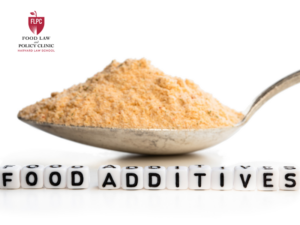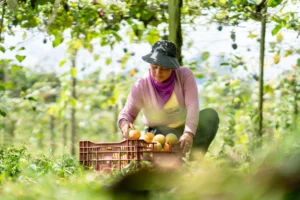Originally published by FBLE on December 12, 2018.
The 2018 Farm Bill just passed the House (368-47), after passing the Senate yesterday (87-13). The Bill now goes to the President’s desk.
Here is the 10,000 foot view of the 2018 Farm Bill as it relates to FBLE priorities:
Food Waste
FBLE is thrilled to see that all of the provisions in the House and Senate drafts of the Farm Bill related to food waste remained in the 2018 Farm Bill. The many provisions included reflect the longstanding recommendations of FBLE member, Harvard Law School Food Law and Policy Clinic. This is the first farm bill to dedicate resources to reduce the nearly 40% of the food supply that we currently waste.
Specifically, the Farm Bill includes eight new provisions and programs to reduce food waste, including pilot funding to support state and local composting and food waste reduction plans in 10 states, creation of a Food Loss and Waste Liaison position within the USDA, and clarification and expansion of liability protections for food donations.
SNAP Work Requirements
The controversial House work requirements for SNAP were mostly dropped in the final Farm Bill. These requirements would have forced more SNAP participants to work or participate in job training for at least 20 hours a week. The House Bill also brought in a larger age group and those with school age children to comply with the work requirements. The bill does reduce state waivers to work requirements from the 2014 Farm Bill. As such, states can exempt only 12% of their SNAP recipients from work requirements, as opposed to 15% in the 2014 Farm Bill. Though the Bill does slightly reduce the amount of state waivers, it preserves geographic exemptions to work requirements in areas with high rates of unemployment and does not implement the inflexible House work requirement program. Protecting SNAP recipients from burdensome work requirements is consistent with FBLE recommendations.
Socially Disadvantaged and Beginning Farmers and Ranchers Studies
The 2018 Farm Bill includes two GAO studies specifically concerning socially disadvantaged farmers and ranchers (SDFR). One studies barriers to and recommendations for accessing land for SDFR and beginning farmers and ranchers (BFR). The other report will study SDFR access to credit. Both reports must be completed within 120 days of the final passage of the Farm Bill and sent to Congress. These reports are consistent with FBLE recommendations to improve access to credit and land for SDFR. They are also representative of FBLE’s forthcoming recommendations on transparency and access to information.
Crop Subsidy Payment Limits
Contrary to FBLE recommendations, the 2018 Farm Bill does not limit commodity payments to high income farmers and ranchers. This was referred to as the Grassley amendment in the Senate version of the Farm Bill. The 2018 Farm Bill maintains the current adjusted gross income (AGI) cap for commodity payments. But the 2018 Farm Bill goes beyond simply maintaining 2014 law and expands the “active personal management” loophole for those who can receive farm bill payments by adding first cousins, nieces and nephews to the definition of family members. These changes could mean a $1 billion cost increase for the commodity title over the next ten years.
Additionally, the bill lacks income limits on crop insurance subsidies, something FBLE had recommended, and still disproportionally benefits the largest farms over small and midsize operations.
Local Agricultural Market Program
In line with FBLE recommendations, the 2018 Farm Bill streamlines small-scale growers’ and producers’ access to markets through the Local Agricultural Market Program (LAMP). Small farming operations often rely on the increased profit margins at farmers markets, value-added products, and direct-to-consumer sales to be financially viable. LAMP merges the Farmers Market Promotion Program, Local Food Promotion Program, and Value-Added Producer Grant. By combining them, the 2018 Farm Bill for the first time provides permanent baseline funding to these programs; however, at a slightly lower level than the programs were funded separately ($213 million over the course of the 2014 Farm Bill and only $200 million over the duration of the 2018 Farm Bill).
Additionally, the 2018 Farm Bill provides opportunities for SNAP payment innovation in ways that will benefit smaller-scale farmers and farmers markets. Specifically, the 2018 Farm Bill makes it easier for farmers markets to accept SNAP. The 2018 Farm Bill also directs USDA to make SNAP benefits useable at online retail stores nationwide, which could provide more opportunities for farmers to sell directly to consumers online instead of through the traditional channel of farmers markets.
The Food Insecurity Nutrition Incentive Program & Produce Prescription Program
The Food Insecurity Nutrition Incentive Program has been renamed the Gus Schumacher Nutrition Incentive Program, and the mandatory funding was dramatically increased from $135 million over the 2014 Farm Bill to $250 million over the 2018 Farm Bill. This aligns with the FBLE recommendation to provide additional support to FINI.
The 2018 Farm Bill also creates a Produce Prescription Program, based on the proposed Harvesting Health pilot program in the Senate bill. However, the Produce Prescription Program does not have dedicated funds, and pulls money from FINI (newly renamed the Gus Schumacher Nutrition Incentive Program). With a nearly doubling of funds in the FINI coffers, this will allow Produce Prescription Programs to become much more available. This aligns with FBLE’s recommendation of more investment in food is medicine; however, FBLE would have liked to see an innovative food is medicine pilot to include medically-tailored meals.
Conservation
The 2018 Farm Bill’s conservation title closely aligns with the Senate version of the Farm Bill. Generally, the 2018 Farm Bill doesn’t cut any money to the conservation title; instead the Bill shifts funds around (primarily by moving money from the Conservation Stewardship Program (CSP) to Environmental Quality Incentives Program (EQIP). You can review FBLE’s analysis of conservation title in the Senate Farm Bill here.
The 2018 Farm Bill is consistent with FBLE’s recommendation on allocation of EQIP funds to animal feeding operations. The 2018 Farm Bill drops the mandatory percentage of funds going to animal feeding operations from 60% to 50%.
Other
Finally, there few other important provisions that you will hear circulating in other news outlets. Namely, the forestry title, which some commentators thought would not make it into the final farm bill, is in the 2018 Farm Bill, and growing non-psychoactive hemp is now legal, so farmers may cultivate it and Land Grant Universities may study it.
Stay tuned as FBLE provides more in-depth analysis of the 2018 Farm Bill.
You can read all 807 pages of House and Senate passed Farm Bill Conference Report here!


Food Law & Policy, Commentary
Policy to Reduce Methane Emissions and Feed More People
April 3, 2025